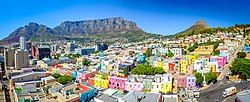Bo-Kaap
| Bo-Kaap | |
|---|---|

Bo-Kaap area of Cape Town with its distinctive pastel coloured houses in the for ground with the city centre to the left and Table Mountain in the background.
|
|
|
|
|
| Coordinates: 33°55′15″S 18°24′55″E / 33.92083°S 18.41528°ECoordinates: 33°55′15″S 18°24′55″E / 33.92083°S 18.41528°E | |
| Country | South Africa |
| Province | Western Cape |
| Municipality | City of Cape Town |
| Established | 1978 |
| Postal code (street) | 8001 |
| Area code | +27 (0)21 |
The Bo-Kaap is an area of Cape Town, South Africa formerly known as the Malay Quarter. It is a former township, situated on the slopes of Signal Hill above the city centre and is an historical centre of Cape Malay culture in Cape Town. The Nurul Islam Mosque, established in 1844, is located in the area.
Bo-Kaap is traditionally a multicultural area. The area is known for its brightly coloured homes and cobble stoned streets.
The museum, which dates back to the 1760s, is the oldest house in the area still in its original form, and well worth a visit. It highlights the cultural contribution made by early Muslim settlers, many of whom were skilled tailors, carpenters, shoe makers and builders. It contains 19th century furnishings which include a fine Cape drop-leaf dining table, Cape Regency-style chairs and a bridal chamber decorated to match the bride's dress.
The museum is distinguishable by its voorstoep—a type of front terrace with a bench at each end emphasizing the polarizing aspect of Cape Muslim culture.
Bo-Kaap Iziko Museum
Bo-Kaap British Style houses
Behind the Iziko Bo-Kaap Museum
Oldest Mosque in Cape Town: Auwal Mosque in the Bo-Kaap
As a result of Cape Town's economic development and expansion, and after the demise of forced racial segregation under apartheid, property in the Bo-Kaap has become very sought after, not only for its location but also for its picturesque cobble-streets and unique architecture. Increasingly, this close-knit community is "facing a slow dissolution of its distinctive character as wealthy outsiders move into the suburb to snap up homes in the City Bowl at cut-rate prices". Inter-community conflict has also arisen as some residents object to the sale of buildings and the resultant eviction of long-term residents.
Daily scene in the Bo-Kaap
The view of Signal Hill from Bo-Kaap
...
Wikipedia




